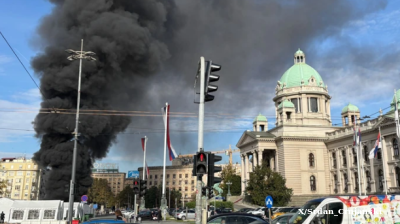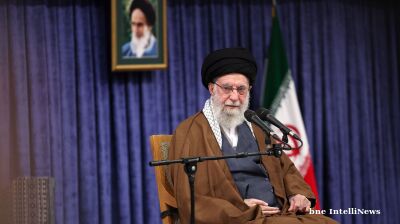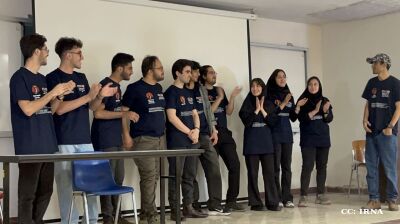Iran has begun building a fourth nuclear research reactor in the central city of Isfahan, days after it broke ground on a mega nuclear power plant (NPP) in the southern Hormozgan province, the state news agency IRNA reported on February 6.
"Today, the process of pouring concrete for the foundation of the reactor started at the Isfahan site," said Mohammad Eslami, the head of Iran's Atomic Energy Organisation.
Eslami added that local experts had totally designed and developed the structure in the latest sign that Iran is shifting away from the now defunct Joint Comprehensive Plan of Action (JCPOA), known as the Iran Nuclear Deal previously signed with the UN Security Council and Germany in 2016.
The new 10-MW reactor would have a variety of applications, including fuel and nuclear material tests and the production of industrial radioisotopes and radiopharmaceuticals.
The multi-purpose open-pool reactor would burn uranium-aluminium oxide as fuel and use light water for cooling and moderation.
The Isfahan Nuclear Research Centre is already home to three reactors built several years ago.
Last week Eslami oversaw the start of a project to develop Iran’s second NPP in the port city of Sirik with a combined production capacity of 5,000 MW of power per day.
The Hormoz NPP is part of Iran’s ambitious plan to generate 20,000 MW of atomic electricity daily in 17 years. Per the comprehensive blueprint, Iran aims to boost the share of nuclear power in its electricity portfolio from around 1% to more than 20%.
"We must reach the production capacity of 20,000 MW of nuclear power in the country by the year 2041," Eslami said during a visit to the region with President Ebrahim Raisi.
He added that some $15bn would be invested to carry out the “megaproject” of Hormoz in four phases, using public sector funds, Russian credit and foreign finances.
Raisi added the country would continue to defend its legitimate rights to the peaceful development of its nuclear programme despite attempts by other countries to stop development.
“Countries that have nuclear weapons are trying to prevent the Iranian people from realising their legitimate right to the peaceful development of the atom, but let them know that we will defend our rights,” IRNA news agency quoted the president.
The International Atomic Energy Agency (IAEA), according to Raisi, has officially declared 15 times that Tehran’s nuclear programme does not deviate from the peaceful path of development.
However, the IAEA, according to the Iranian President, “does not adhere to its statements.” Raisi also recalled the fatwa (decision of the cleric) of the leader of the republic, Ali Khamenei, according to which the development of nuclear weapons contradicts the canons of Islam.
“We have not left the negotiating table and will not leave. We have always taken steps to clarify our position both to the agency (IAEA) and to countries that want to know in which direction Iran will use nuclear energy.
"Logically, they first imposed wars on us, and then also imposed sanctions. Neither war nor sanctions could prevent Iran from achieving its goals," the president of the Islamic Republic added.
On February 6, IAEA Director General Rafael Grossi said he was considering visiting Iran in February or March to discuss the further development of its nuclear program.
On February 2, Grossi reported that the sharp increase in the production of highly enriched uranium in the republic had begun to decline. Still, at the same time, it continued to accumulate uranium enriched to 60%.
With further enrichment (above 90%), uranium can be used to create nuclear weapons.
According to IRNA, each phase of the new plant would include a 1,250-MW unit with a generation III reactor at its heart. The first unit is projected to join the national power grid by 2028, while the whole project, the partnership of Iranian and foreign companies, is expected to be completed by 2031.
The United States, France, China, Russia and South Korea are the only five countries in the world that currently have more than 20,000 MW of nuclear capacity installed.
Iran currently has one operational NPP in the southern port city of Bushehr, producing 1,000 MW of power per day.
News

India, US near major trade deal cutting tariffs to 15–16% if New Delhi will limit Russian crude imports
India and the United States are close to finalising a long-awaited bilateral trade deal that could sharply lower tariffs on Indian exports to about 15–16% from the current average of 50%

Mongolia’s PM to stay in power after court rules dismissal illegal
Observer says opponents of Zandanshatar Gombojav “rushed and sloppily handled motion” to dislodge him. Second attempt to vote him out not expected.
_1761147529.jpeg)
China accuses Washington of “bullying” over visa ban threats in Central America
China has sharply criticised the United States for its decision to impose visa restrictions on Central American officials and citizens accused of ties to the Chinese Communist Party, describing the move as evidence of American “arrogance and bias."

Serbian president calls fire, shooting outside parliament a terrorist attack
The attacker, a retired employee of the former State Security Service, opened fire on a tent settlement of pro-government supporters.




